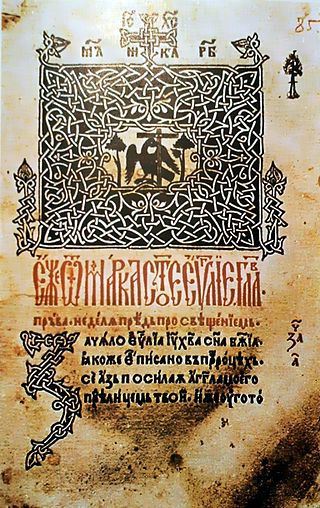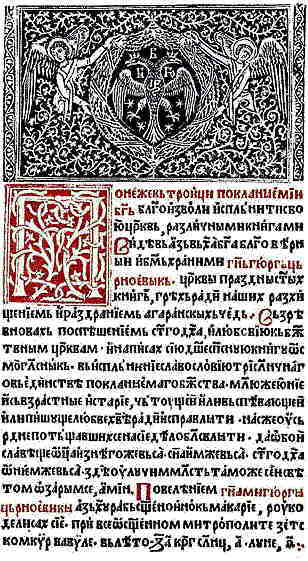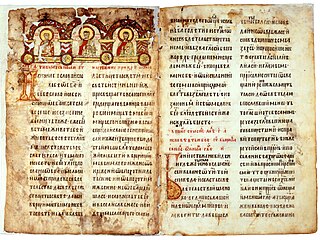
Hieromonk Makarije is the founder of Serbian and Romanian printing, having printed the first book in Serbian and the first book in the territory of Walachia.

Trojan Gundulić was a merchant and printer from the Republic of Ragusa who is remembered for his participation in the Belgrade printing house, The Four Gospels ("Četverojevanđelje").

The Cetinje Octoechos is an Orthodox liturgical book printed in 1494 in Cetinje, the capital of the Principality of Zeta. It is the first incunabulum written in the Serbian recension of Church Slavonic, as well as the first book printed in Cyrillic in Southeast Europe. The octoechos was produced under the direction of Hieromonk Makarije at the Crnojević printing house, which was founded in 1493 by Đurađ Crnojević, the ruler of Zeta. Printed in two instalments, its first volume contains the hymns to be sung to the first four tones of the Octoechos system of musical modes, and the hymns for the remaining four tones are included in the second volume. The two volumes are called Octoechos of the First Tone and Octoechos of the Fifth Tone, respectively.

The Crnojević printing house or Cetinje printing house, was the first printing house in Southeastern Europe; the facility operated between 1493 and 1496 in Cetinje, Zeta.

Božidar Vuković was one of the first printers and editors of Serbian books in Montenegro. He founded the famous Vuković printing house in Venice. His printing house was operational in two periods. In first period 1519–21 three books were printed. In the second period 1536–40 two books were printed.
Vićentije "Vićenco" Vuković was a printer and editor of books in Serbian in the Republic of Venice, and son of the predecessor, Božidar Vuković, and partner of Jerolim Zagurović, Jakov of Kamena Reka and Stefan Marinović. He had succeeded the noble title from his father, but was patriotically self-styled as Serbian Despot, since the last official Serbian Despot, Pavle Bakić, had died in 1537.

Stefan Marinović, also known as Stefan of Scutari was a 16th-century Serb printer from Scutari. He printed his books first in Venice and then in Scutari. Marinović always emphasized that he was "of the city of Scutari".

The Goražde printing house was one of the earliest printing houses among the Serbs, and the first in the territory of present-day Bosnia and Herzegovina. Established in 1519 in Venice, it was soon relocated to the Serbian Orthodox Church of Saint George in the village of Sopotnica near Goražde, in the Ottoman Sanjak of Herzegovina. It was founded and run by Božidar Ljubavić, also known as Božidar Goraždanin, who was a prominent merchant from Goražde. His son Teodor Ljubavić, a hieromonk of the Mileševa Monastery, managed the work of the printing house. It worked until 1523, producing three books, which are counted among the better accomplishments of early Serb printers.

The 1791 German–Serbian dictionary, referred to as the Avramović Dictionary, is a historical bidirectional translation dictionary published in the Habsburg Empire's capital of Vienna in 1791, though 1790 is given as the year of publication in some of its copies. Containing around 20,000 headwords in each direction, it is the largest Serbian dictionary of the 18th century. Vuk Karadžić possibly used it as a source for his Serbian Dictionary, which first appeared in 1818 as the first book in modern literary Serbian.
Božidar Ljubavić, better known as Božidar Goraždanin, was founder of the Goražde printing house, the second Serbian language printing house and one of the earliest printing houses on the Balkans. Since 25 October 1519 he printed books on Cyrillic alphabet, first in Venice and then in the Church of Saint George in Sopotnica, Sanjak of Herzegovina, Ottoman Empire in period 1519–23. Only four printing presses were operational during the entire Ottoman period in Bosnia. The first press was press of Božidar Goraždanin while other three presses existed only in the 19th century. In 1523 his printing house became nonoperational.

A srbulјa, srbulje in plural, is a liturgical book written or printed in the Serbian recension of Old Church Slavonic, which was the written language of Serbs from the 12th century to the 1830s. The term was used for the first time by Vuk Karadžić in 1816 to differentiate liturgical books written in the Serbian recension from those written in the Russian recension, which gradually replaced srbulje at the beginning of the 19th century.
Hieromonk Pahomije was a Serbian Orthodox hieromonk and one of the first printers of books in the Serbian language. He learned his printing skills from Hieromonk Makarije at the Crnojević printing house in the period of 1494–96. In 1518 he accepted the invitation of Božidar Vuković and went to Venice where he organized printing at the Vuković printing house in the period of 1519/1520–21.

Jerolim Zagurović was a Serbian-Venetian printer of Serbian Cyrillic books (srbulje). Zagurović and Vićenco Vuković were the last printers of srbulje books.

The Vuković printing house was 16th century printing house established in Venice by Božidar Vuković.
Hieromonk Mardarije was a Serbian Orthodox hieromonk and one of the most important early Serb printers. Mardarije was the first Belgrade printer and last great printer of srbulje books. Mardarije first printed books at the Belgrade printing house in 1552. When its owner gave up the printing business, he moved the printing press to Mrkšina crkva monastery in Kosjerić where he established the Mrkšina crkva printing house.
Hegumen Mardarije was a Serbian Orthodox monk and one of the first printers of Serbian language books.

The Mileševa printing house was a printing house established in 1544 in the Mileševa monastery near Prijepolje, Ottoman Empire. Three srbulje books were printed in this printing house. Two in 1544 and 1545 and one in 1557.
Stefan Paštrović was a Serbian Orthodox hieromonk of Monastery of Gradište in Buljarica. He descended from the Paštrovići coastal tribe in modern-day Montenegro. According to some sources his position was hegumen.
Mojsije of Dečani was a printer of srbulje liturgical books and Orthodox hierodeacon.
Stefan von Novaković was a Serbian writer and publisher of Serbian books in Vienna and patron of Serbian literature.











